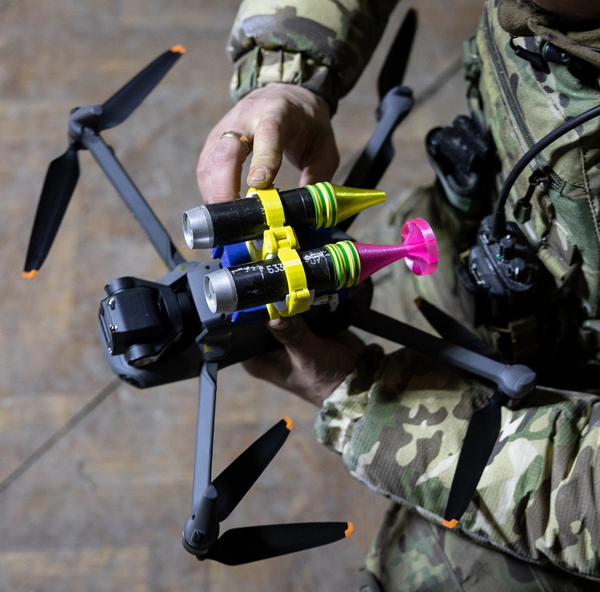This is Naked Capitalism fundraising week. 1147 donors have already invested in our efforts to combat corruption and predatory conduct, particularly in the financial realm. Please join us and participate via our donation page, which shows how to give via check, credit card, debit card, PayPal, Clover, or Wise. Read about why we’re doing this fundraiser, what we’ve accomplished in the last year, and our current goal, bonuses for our esteemed writers.
Charles Darwin’s enduring legacy rests not only on his discovery of natural selection, but also on the extraordinary breadth of its explanatory power. Evolutionary theory is applicable to all manner of systems from biology to behavior, and now, the technology of war. Today, the evolutionary logic of adaptation and survival is playing out in drone warfare.
The war in Ukraine has become the first full-scale conflict in which drones dominate every zone of combat, from trench lines to strategic deep strikes. What began as a desperate improvisation with civilian quadcopters has transformed into a relentless contest of innovation, countermeasures, and counter-countermeasures. Each new adaptation on the battlefield triggers a quick technological response, greatly reducing the gap between research and deployment.
This rapid evolution has turned Ukraine into the world’s most dynamic military drone laboratory. The conflict now demonstrates that airpower is no longer the exclusive province of state air forces. Instead, a distributed ecosystem of relatively inexpensive, software-driven systems can achieve effects once reserved for costly precision-guided missiles and manned strike aircraft. Understanding how this transformation unfolded offers critical lessons for militaries worldwide.
Improvised Beginnings
In the chaotic opening months of 2022, Ukraine faced a numerically superior invader. Its early edge came not from high-end Western platforms, but from consumer drones bought off the shelf. Civilian quadcopters like the DJI Mavic, costing under $2,000, were repurposed to spot artillery targets and adjust fire in real time. Soon these drones were modified to deliver munitions, making them precision-guided weapons.
Weaponized drone – small but deadly
Grassroots networks of volunteers, tech hobbyists, and veterans formed ad hoc units such as Aerorozvidka, pioneering battlefield hacks: 3D-printed bomb racks, modified GoPro cameras, extended-life batteries. These innovations converted hobby drones into lethal spotters and light bombers. The effect was immediate: artillery accuracy improved, small units gained real-time intelligence, and morale surged as soldiers saw their own strikes broadcast live.
Russia, relying on traditional reconnaissance and centralized command structures, was initially slow to adapt. The early months thus marked a paradigm shift: drone improvisation delivered an artillery multiplier and direct attack weapons. A new arms race had begun.
Industrialization and Swarming
By mid-2023, improvisation gave way to industrialization. Both sides recognized drones as indispensable, and domestic production lines emerged to meet insatiable battlefield demand. The First Person View (FPV) revolution, repurposing high-speed racing drones into precision-guided loitering munitions, transformed tactics. Pilots, wearing video goggles, steered drones directly into enemy armor or fortifications, achieving precision strikes at a fraction of the cost of guided missiles.
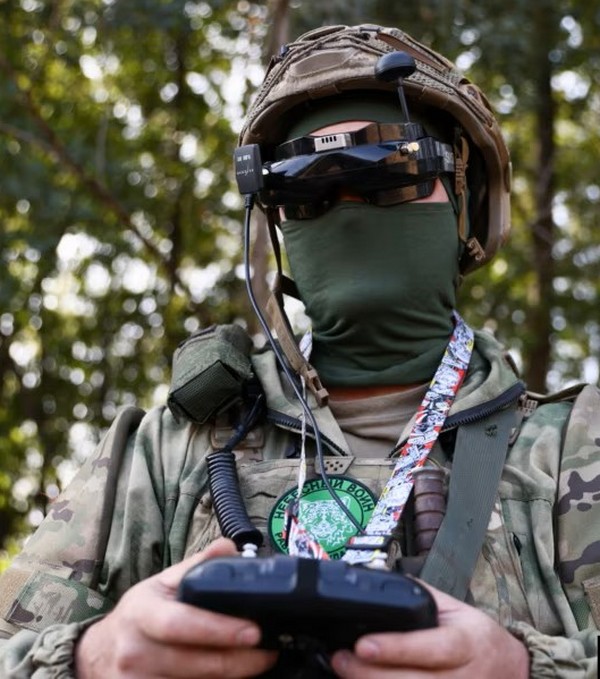
FPV drone operator – a view to a kill
Ukraine’s decentralized model encouraged rapid iteration: components sourced globally, assembled locally, and tested within days. Russia responded with mass production of its own FPV systems and dedicated electronic warfare (EW) units. This set off a new electronic duel — with jamming, frequency hopping, and anti-jamming technologies evolving in near-real-time.
The result was a shift from occasional drone use to persistent aerial presence. Every trench, armored column, and supply route now operated under constant observation. The swarm had arrived, and with it, a new definition of air superiority measured in volume and duration of battlefield coverage.
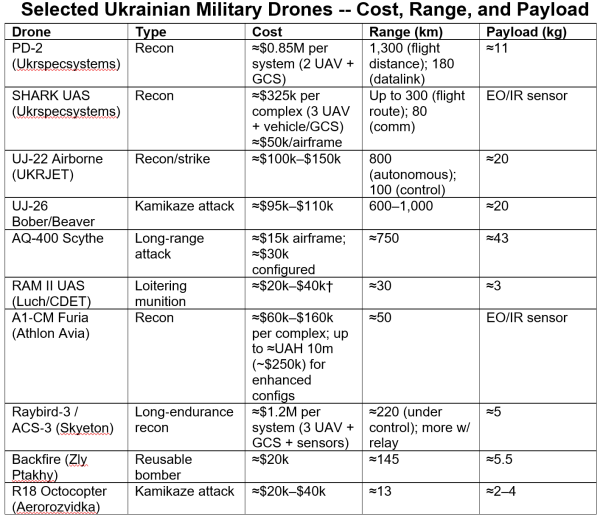
Strategic Deep Strikes
As capabilities matured, the battlespace expanded. Ukraine began launching long-range drones deep into Russian territory, striking oil depots, airbases, and even the outskirts of Moscow. Many of these systems combined legacy Soviet engines with modern guidance — a fusion of old hardware and new software.
These attacks were not merely tactical disruptions; they carried profound psychological and strategic effects. Russia, which once enjoyed sanctuary in its heartland, now faced nightly alerts and scrambled interceptors. The cost-exchange ratio favored Ukraine: a drone worth tens of thousands forced the diversion of million-dollar air defenses and civilian anxiety in major cities.
Moscow adapted with dense radar coverage and layered SAM networks, yet no defense can guarantee immunity from low-observable, expendable threats. The drone had erased the boundary between front and rear, turning the entire theater into a contested zone.
The Techno-Operational Feedback Loop
Perhaps the most striking feature of the drone war is its compressed innovation cycle. In traditional procurement, weapon systems evolve over years; in Ukraine, weeks suffice. Every tactical success triggers imitation and countermeasure. A new FPV mount appears on Telegram today; by next week, adversaries are testing defenses.
This constant experimentation mirrors a Darwinian process of selection: designs that succeed under fire propagate instantly across the front, while ineffective models vanish from production lines. Crowdsourced R&D blurs the line between soldier and engineer. Volunteer collectives fund projects, share code, and publish field results openly.
A vivid illustration is the rapid adoption of fiber-optic guidance in frontline FPV systems. As electronic jamming intensified, degrading radio-controlled drone links, Ukrainian and Russian engineers independently revived the concept of tethered control over a fiber optic cable, drawing inspiration from anti-tank missiles like the 9K135 Kornet. Within months, drones equipped with spooled micro-cable guidance appeared in combat, immune to radio interference and capable of precision strikes in heavily jammed zones. Though the added weight and limited range impose trade-offs, the innovation demonstrates the agility of combatants to iterate under pressure, substituting one evolutionary constraint (mobility) for another (resilience). Each adaptation feeds back into the next design cycle, refining the balance between connectivity, survivability, and lethality.
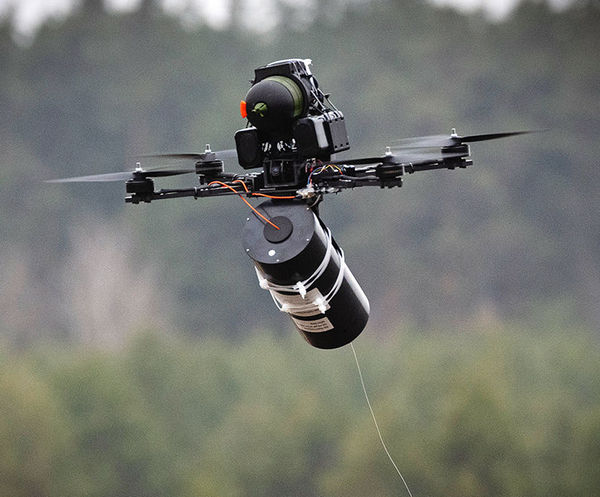
Fiber optic drone – jam-proof guidance
Artificial intelligence increasingly enters the evolutionary process. AI software for targeting, automated navigation, and swarm coordination is in active development and is being deployed. This battlefield natural selection rewards adaptability over pedigree. Survival depends less on industrial scale than on the agility to reconfigure tools faster than the opponent. It is warfare at startup speed — iterative, experimental, and unforgiving.
🇷🇺💥🇺🇦
BREAKING NEWS !!!
Russian “Gerani” have started hitting moving targets
▪️In the Chernihov region, for the first time, a strike was recorded on a Ukrainian railway echelon carrying fuel while it was moving 150-200 km from the border.
The new drone model is equipped… pic.twitter.com/gIhSX0qNfl
— 𝐃𝐚𝐯𝐢𝐝 𝐙 🇷🇺 🇷🇺 (@SMO_VZ) October 1, 2025
The Evolution of the Shahed-Type Drone
In parallel with the tactical FPV explosion, a separate evolutionary branch of Russian drones emerged, based on the Iranian Shahed family of long-range drones. These propeller-driven, delta-wing, loitering munitions were conceived for affordability and range rather than precision. Introduced into the Ukraine war in late 2022, they represented the first mass-produced strategic drone species, optimized for long endurance, minimal radar cross-section, and saturation attacks.
Early Shahed variants exhibited crude navigation and limited accuracy, but successive Russian iterations, notably the Geran-2 versions, incorporated improved guidance, GLONASS satellite navigation modules, and domestically sourced components to bypass sanctions. Over time, adaptations enhanced reliability, fuel efficiency, and warhead stability, making the Geran an increasingly fit organism in the Darwinian ecosystem of long-range warfare.
This drone’s value lies less in sophistication than in niche dominance: it can travel hundreds of kilometers, evade some air defenses through low-altitude routing, and force defenders to expend costly interceptors. A single Patriot interceptor costs about $4 million, whereas the cost of a Geran strike drone is estimated at $40k–$200k. The exchange ratio therefore favors saturation tactics imposing significant asymmetric costs on Ukraine.
As production shifted to Russian soil, the Shahed’s evolution accelerated. Domestic assembly lines now produce hybrid models blending Iranian airframes with Russian avionics and engines, forming a localized subspecies, the Geran, suited to the Eurasian theater. Deployed in waves, these drones overwhelm defenses through numerical superiority, a survival strategy based on replication rather than innovation. There are reports of new Russian Gerans that are jet-powered, doubling speed and increasing the difficulty of interception.
In biological terms, the Shahed/Geran lineage exemplifies stabilizing selection: a design refined not by radical mutation but by iterative optimization within a specific environment, the long-range strike domain. Its persistence underscores a key truth of drone warfare: evolutionary success requires not only novelty, but reproducible sufficiency.
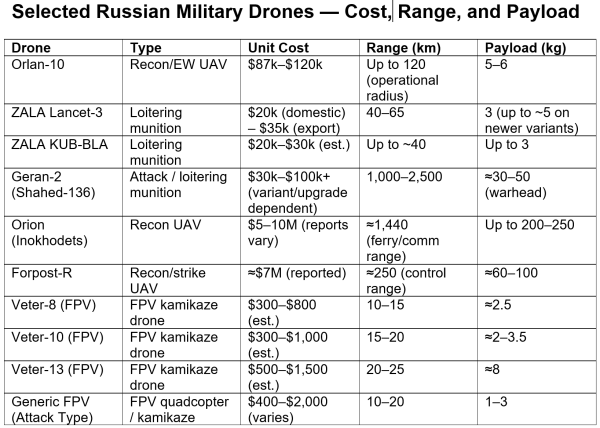
Russia’s Drone Manufacturing Capacity
While Ukraine has excelled in innovation and agility, Russia has exploited its industrial depth and centralized production efficiency to seize an advantage in drone manufacturing. By late 2024, multiple Ukrainian and Western sources claimed that Russian output of FPV and reconnaissance drones exceeded 100,000 units per month, although these estimates are contested. The broader picture is clear even amid uncertainty: Russia has emphasized standardization, volume, and resilient supply chains, while Ukraine has excelled at rapid, field-driven innovation. One model prioritizes continuity at scale; the other prioritizes agility. Matching Russia’s throughput would require coordinated production, hardened supply lines, and shared standards across Ukraine’s partners.
This scaling capacity reflects an evolutionary bifurcation: Ukraine’s ecosystem thrives on rapid experimentation and field-driven adaptation, while Russia’s model emphasizes standardization, volume, and logistical resilience. The former favors novelty; the latter ensures continuity. As a result, Russia now fields a steady and growing supply of uniform, interoperable drones, a critical asset in sustained attrition warfare.

Geran drone production – quantity matters
This industrial edge may prove decisive in a prolonged conflict. In evolutionary terms, Russia’s advantage lies not in variation, but in reproductive fitness: the ability to replicate successful designs faster and at greater scale than the adversary. For Ukraine and its Western supporters, matching this capacity would require coordinated production, supply-chain resilience, and shared technical standards, a challenging industrial mobilization of innovation.
Ukraine’s war effort is highly reliant on energy and rail transport infrastructure. These are elaborate networked facilities, highly resistant to scattered strikes, but with extensive long-range drone attacks, Russia may be able to cripple the Ukrainian energy and rail systems. Estimates put the current output of Russian Geran drones at around 100 a day. In Ukraine, there are roughly 90 330 kV electricity distribution substations, which are the energy supply backbone of the electrified rail network, and there are approximately 500 to 1,000 diesel locomotives. Recent numerous Russian drone strikes on energy infrastructure and trains suggest that a tipping point may be near, with ominous consequences for Ukraine.
Countermeasures?
Despite extensive efforts to devise effective countermeasures against attack drones, the drones have the upper hand. Electronic jamming is only partially effective against radio controlled drones and useless against fiber optic guidance. Vehicles with protective screens or cages may stop a single strike but will not survive multiple drone hits. Guns can’t reach drones at high altitude, and interceptor missiles are too expensive to use in large numbers. Anti-drone drones have had some success, but their interception envelope is limited. Drone evolution has simply outpaced the technical capabilities of defensive systems, and there are no near-term remedies in sight. Defensive innovation is lagging; unless radically accelerated, the imbalance will persist.
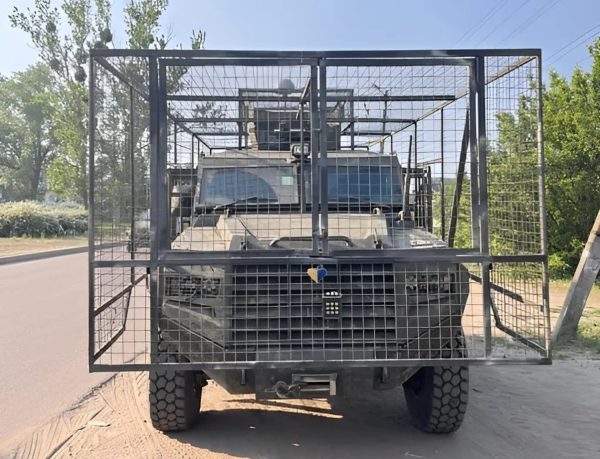
Anti-drone cage – no guarantee of survival
Strategic and Doctrinal Implications
The proliferation of cheap, effective drones undermines long-standing assumptions about force structure. Cost asymmetry has become decisive: a $500 FPV drone can disable a $10 million tank. Traditional metrics of military power, tonnage, armor thickness, sortie rate, lose relevance when quantity and expendability outweigh mass. Moreover, an unfavorable cost exchange ratio against interceptor missiles places a further burden on defenders.
Persistent aerial surveillance erodes concealment, rendering static defenses and troop concentrations hazardous. The old doctrine of maneuver under cover is obsolete in skies saturated with loitering sensors. Armies must now disperse, camouflage electronically, and expect continuous observation. Psychologically, the overhead buzz of drones has reshaped infantry experience, inducing fatigue and hypervigilance. Meanwhile, the democratization of airpower decentralizes control, empowering small units while complicating battle management.
Doctrinally, this represents not just technological adaptation but evolutionary divergence: forces that fail to adjust face extinction on a battlefield where iteration is survival. For major powers, the message is clear: future combined-arms operations must integrate drone defense as thoroughly as armor or artillery. Air superiority will depend as much on jamming and counter-UAS tactics as on fighter jets.
Global Lessons and Policy Outlook
The lessons of Ukraine are already global. Taiwan studies FPV tactics for coastal defense; Israel integrates micro-drones into urban operations; Iran refines exportable loitering munitions. NATO militaries, once skeptical of non-traditional platforms, now race to replicate Ukraine’s innovation pipelines. Yet ethical and legal frameworks lag far behind. Civilian infrastructure and urban centers increasingly fall within drone range, raising questions of proportionality and accountability. The dual-use nature of components, from lithium batteries to GPS modules, complicates export controls and sanctions.
For major powers, industrial policy must pivot toward micro-production ecosystems emphasizing software, autonomy, and rapid iteration. Nations with both strong technology capabilities and mass manufacturing resources will have advantages in large-scale conflicts, but drone technology also enables asymmetric warfare by smaller nations and non-state actors. Proliferation of drone weaponry is already taking place, and this may lead to growing instability in conflict regions worldwide.
Conclusion
In less than three years of the Ukraine war, drones have evolved from aerial scouts to potent strike systems. The transformation reveals more than technological ingenuity; it signals a structural shift in warfare itself. The conflict demonstrates that adaptation is the critical success factor. Survivability and effectiveness derive not from thickness of steel or caliber of shell, but from speed of innovation. Like organisms in a hostile ecosystem, drone systems that fail to evolve perish swiftly, while those best suited to the environment propagate across the front. As nations absorb these lessons, the war in Ukraine foretells the drone warfare of the future: dense, autonomous, and in constant flux. Aerial supremacy no longer belongs to conventional manned air forces. In the drone-saturated battles of tomorrow, victory will belong not to the strongest, but to the swiftest to evolve.


